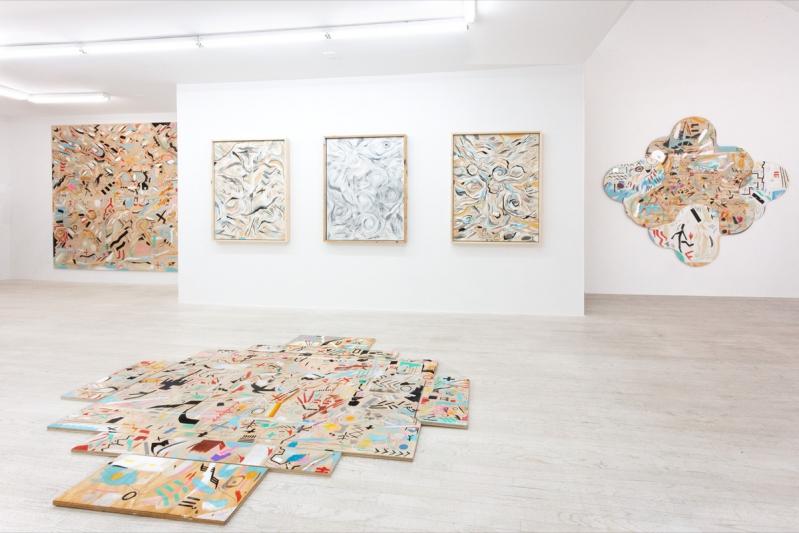Matthew Kirk's artwork has been compared to that of Jackson Pollock, Cy Twombly, Bradley Walker Tomlin, and now, in "White Snake," the latest show of his work at Halsey McKay in East Hampton, Dieter Roth.
The artist has so much going on in his work, but it's important to stop to consider who exactly we are comparing him to and whether it is helpful or accurate given his own background. Being half Navajo, the kind of mark-making he engages in should be considered sui generis and not an indirect distillation of art made by outsiders intrigued and inspired by his own heritage.
In "White Snake," Mr. Kirk eschews the wallboard that defines his earlier series for plywood. The style and form of the compositional elements and many of the mediums remain similar, but the new support seems to free him to consider other possibilities for placement and extension into other dimensions. What might have been a wall hanging moves to the floor. What once were triptychs are now hinged objects that move in and out of a third dimension.
They were crafted from the floors, walls, and tables of his studio -- found objects culled from his own surroundings.
The floor works captured the imagination of Halsey McKay's staff, who have said they are reminiscent of Dieter Roth's floor works and his practice, which embraced "accidents, mutations, and accretions of details over time," according to a press release in which they quoted from Hauser & Wirth. In a 2015 interview in Modern Painters magazine, Mr. Kirk noted that the accidental and unexpected appeal to him.
There is something about an artist tearing up his studio to make art objects that is reminiscent of a snake eating itself, and maybe that is part of the allusion in the title of the show. Regardless, the repurposed materials result in artwork that is regenerative and transformational, and there are even some more traditional canvases that the artist has thrown in the mix. These, however, are treated much the same way as his other works, using chalk, graphite, and acrylic paint marker to make more painterly compositions still steeped in symbolism.
The canvases on view emit a certain wave energy or rhythm. It's as if freed from the necessity to represent something, the lines have broken away and move in their own self-sustained pattern. The center canvas is festooned with whorls, but the two outer ones tend to undulate in no structured way. The one on the right has some whorls but the lines appear to be spiraling away rather than collecting at their hubs.
With the M.F.A. so central to successful careers in the current art world, it is refreshing to remember that Mr. Kirk has no such credential and does not traffic in the same products of the self-perpetuating creative machine that are deemed important art by today's galleries and collectors. As such, his work is bracing and fresh. Known better to attendees of outsider art fairs and events than the mainstream art market, his work might seem surprising at first, but his pieces play well with others, and the cumulative effect is one of building, not cacophony.
The gallery noted that his work in this show matches Roth's own practice, prizing the emotional experience of the art over what it is made of materially, and allowing for happy accidents and other ways of evolution over time. More so than usual, the objects that Mr. Kirk created from his studio's construction materials assume shapes that contain references to natural phenomena and man-made objects. Some forms have improvised legs and feet, and yet the viewer wonders if they are falling into the trap of anthropomorphizing them, since in reality the "legs" in one piece are just stacked bricks and a dowel.
Much of the painted surfaces demonstrate a horror vacui, but then there are small sections where not much is going on. These tend to pull one in, allowing the entry that the densely configured portions do not. This also lets us contemplate the symbolic and often ironic nature of the compositions and their supports and relate them to both the experience and visual language of the Navajo as well as the contemporary American scene.
There are some sculptural works as well, as spare as a trunk wrapped in a cuff of yellow plastic to more complicated forms, stacked boxes that act as tableaux, and some canvas-wrapped posts painted in glyphs similar to his plywood pieces, seeming like stubbed cigarettes or standing figures grouped around a bar table.
The exhibition, which is on view with Corinne Chase's art upstairs, will close on March 20.




